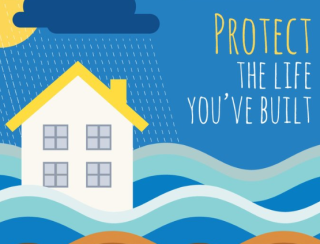Protecting Your Home

General/Meetings-Advice
Mitigation is the effort of reducing the loss of life and the damage to property by lessening the impact of flooding events. Mitigation can keep natural hazards, like flooding and hurricanes, from having catastrophic impacts. By reducing a property’s risk to future events, residents can return home quicker after an event. There are a wide range of options for protecting your home from flooding events through mitigation measures. To ensure regulations/ requirements are followed while conducting mitigation activities, be sure to consult with a licensed contractor and the Construction Department before making any structural changes.
The Borough offers a program where contractors and residents may request a meeting with the Building Construction Official. We will provide one on one property protection measures advice on the building regulations required to comply with federal flood standards . Call the Construction Department at (732) 475-6983 for advice.
Additional Information:
FEMA P-55, Coastal Construction Manual
https://www.fema.gov/media-library/assets/documents/3293
Protecting Your Home And Property From Flood Damage
https://www.fema.gov/sites/default/files/2020-11/fema_protect-your-home_...
Homeowner's Guide to Retrofitting
https://www.fema.gov/sites/default/files/2020-08/FEMA_P-312.pdf
Flood Hazard
What is your flood hazard:
1. Check with your Construction Department at (732) 475-6983 for flooding information in your area. Some questions you might ask are:
- Where does the water come from?
- Are you in the mapped Special Flood Hazard Area or floodway as shown on https://msc.fema.gov/portal/home?
- Are you in coastal high hazard area or V Zone as shown on https://msc.fema.gov/portal/home?
- How bad has it been in the past?
- How bad could it be? (Remember, the next flood can be worse than the last one.)
- What is an appropriate flood protection level, BFE? (How high should you prepare for?)
2. Check out your local drainage situation.
- Does water flow away from your house or does it tend to stand next to your walls?
- Is the ditch, stream or storm sewer that takes water away clear of debris or obstructions?
- Do the downspouts from your roof gutters direct water well away from your house?
- Do you have a sump pump? If so, does it direct water well away from your house?
Elevation
Elevations:
One of the most common retrofitting methods for homes is elevation. When a home is properly elevated, the living area should be above the base flood levels. Several elevation techniques are available. In general, they involve lifting the home and building a new foundation or extending the existing foundation below it.
During the elevation process, most frame, masonry veneer, and masonry homes are separated from their foundations, raised on hydraulic jacks, and held by temporary supports while a new or extended foundation is constructed below. The living area is raised so that only the foundation remains exposed to flooding. This technique works well for homes originally built on crawlspace, and open foundations. When homes are lifted with this technique, the new or extended foundation can consist of continuous walls or separate piers, posts, columns, or piles.
Utilities
Utilities:
Thousands of dollars in damage can be prevented by simply moving furniture and electrical appliances to a higher level. A significant portion of flood damage is attributed to critical building systems (mechanical, electrical, plumbing and other utility elements). Residents, communities and businesses are all impacted when building utility systems are damaged, causing delays in post-flood building re-occupancy.
Be sure to:
- Elevate or flood proof HVAC and/or mechanical units, ductwork, electrical systems, and other utilities above the DFE to protect against flood damage and reduce repair costs.
- Install flood vents in foundation walls, garages, and other enclosed areas. Flood vents reduce flood damage by allowing water to flow through and drain out.
- Anchor any fuel tanks to the floor and make sure vents and fill line openings are above the BFE (this may require permission from your fuel provider). A fuel tank can tip over or float in a flood, spilling fuel and becoming a fire hazard.
- Install a backflow valve on your sewer system to prevent sewage back up in your home.
During an Event
If you have time before a flood:
- Turn off all utilities at the main power switch and close the main gas valve if evacuation appears necessary.
- Move valuables, such as papers, furs, jewelry, and clothing to upper floors or higher elevations: house deeds, renter’s lease, social security cards, prescriptions, birth certificates, and other identification documents should be kept together for evacuation in an accessible place.
- Bring outdoor possessions, such as lawn furniture, grills and trash cans inside, or tie them down securely.
- Throughout the year trim and cut back any tree limbs that could cause damage during a storm.
Preparing your Home for Disaster:
- Installing permanent storm shutters or barriers over doors and windows on a home ensures the best storm protection.
- Winds during strong storms and hurricanes can cause debris and materials to pummel a home, breaking through windows and doors, causing both structural damage and water damage by exposing a home to the outside elements.
- The best time to prepare a home is well before a storm threat, during the actual design process of the home so shutters and barriers can be retrofitted into the actual design of the home, but mitigating a home for hurricanes can also be done long after a home has been built.
- Windows and doors can be boarded up using plywood, preferably a marine grade or exterior grade wood with 5/8 inch thickness or greater. Taping windows does little to nothing during a major storm.
- If nothing else, remove valuables away from windows and doors and try to keep items in a room without outdoor access or an upper story if possible.
- If there is enough time, remove any perishables from the fridge or freezer to keep foods from spoiling during a power outage.

